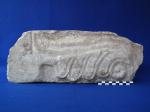
Illustrations
- No uploaded files
Description
- Medieval low relief
- White marble
- 1
- 38.0
- 15.0
- 13.0
- All surfaces chipped, pitted and discoloured. The block appears to have been cut down along its two long sides and was broken on one of its short ends.
- AE 1061 is a fragment of a post made from a reused Roman inscription block. It preserves along the length of one side a narrow groove (5 cm wide, 2.5 cm deep), part of the system of tongue-and-groove joints by which the chancel barrier was assembled. AE 1061a preserves the lower-right corner of a diagonal grid of trisected bands that weave in and out of a straight grid of circles. The bands cross at the center of each circle, when they arrive at the pattern's edge they turn back at an acute angle. AE 1061b preserves an undulating, trisected band with a series tear-shaped lobes emerging from one side.
- Local examples of two-faced chancel barriers can be found in the churches of Ferentino and Rome. See, for example, two ninth-century fragments housed in Rome's Museo dell'Alto Medioevo (Melucco Vaccaro and Paroli 1995, nos 34 and 54).
- The pattern on AE 1061b is a variant of a common pattern consisting of a grid of interlocking circles with palmate interiors, as seen on fragments AE 31 and AE 557. The spiral terminating in a flat, disk-like eye can also be seen on AE 556, AE 825, AE 1049, AE 1050, AE 1134.















![Download [view]](/villamagna/ark//skins/villamagna/images/results/download_sml.png)
